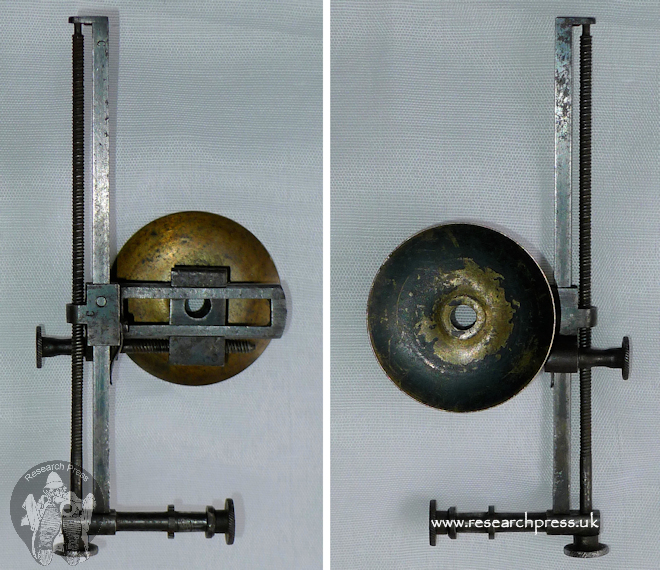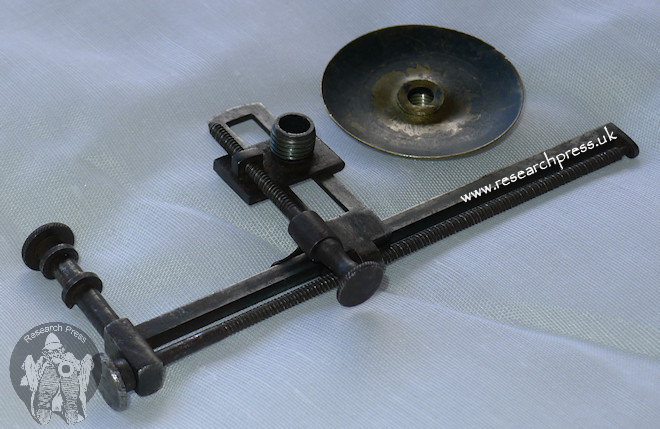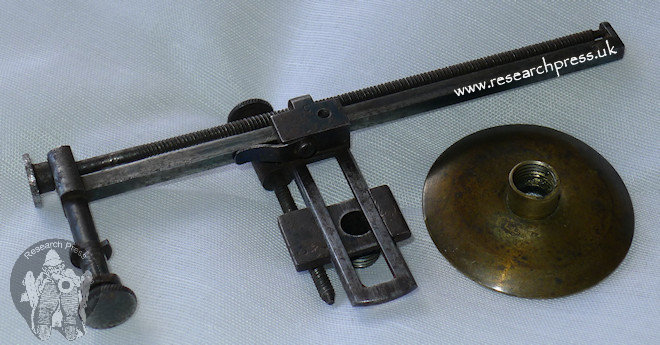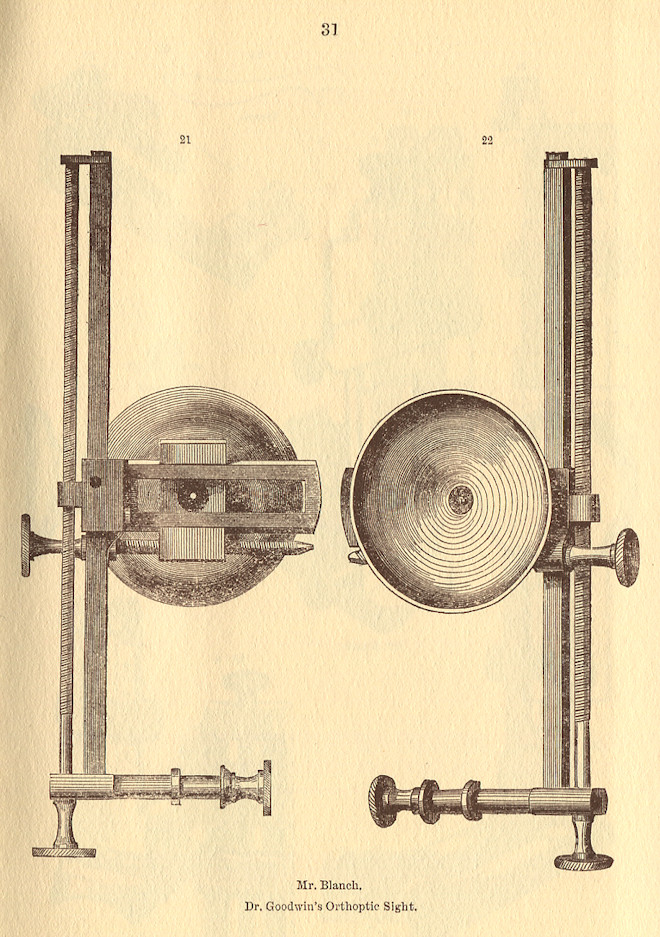You are here: Home > Firearms > Accessories
Written by: David Minshall
A Volunteer Soireé took place at Willis’s Rooms, St. James, London, on 27 and 28 March 1863 and items for exhibition were sought. Amongst those that supported the event was the Liverpool gun and rifle maker William Blanch. His exhibits included Dr. Goodwin’s orthoptic sight, the inventor also being on hand to describe the sight to curious riflemen.
Positive comments about the sight appeared in the press, the earliest such notice so far found by the author was published in the Volunteer Service Gazette, 14 March 1863:
Mr. Ashton, of Liverpool, made the following score on his range at Formby, March 7th, with a Turner rifle, fitted with Blanch’s Vernier sight and Dr. Goodwin’s orthoptic screen sight; range, 200 yards:
2 2 2 3 3 3 3 3 3 3 3 3 3 3 3 3 3 3 3 3 3 3 3 3 3 3 2
The following is a copy of Mr. Ashton s letter on the subject: “Forwood, Formby, March 5, 1863 – Dear Dr. Goodwin, – You will, if possible, be more gratified than I am with the report of this my first afternoon’s practice with your most excellent ‘orthoptic sight.’ The three first shots may be fairly considered trial shots, as the whole machinery of your sight was a perfect novelty to me. After once getting satisfactorily on the bull’s-eye, I made twenty-three bull’s-eyes in succession! a score that, venture to say, has never been equalled. What I consider remarkable is, that after the first three shots, the elevation was always correct, and the twenty-seventh shot, when I finally broke down, was so very near to be (liberally construed) a bull’s eye also. Believe me, my dear Dr. Goodwin, yours faithfully, A. Ashton.”
The Liverpool and Southport Rifle Club, in addition to prizes won in competition, also awarded badges of merit to members for extraordinary scores made in club practice. At their annual meeting on 27 May 1863 one such award was made to Mr. Blanch for making 20 marks out of five shots at 700 yards. Mr. Blanch, in speaking of his success, said, “if there was anything at all respectable in the scores he had made, he must give Dr. Goodwin the credit, as they were made using his excellent orthoptic sight. Of one thing he was confident, that he could never have made such steady shooting without the sight to which he had alluded, for, until he used it he had not obtained a figure of more than ordinary merit” (Volunteer Service Gazette, 13 June 1863).
In reporting upon the National Rifle Association’s annual rifle meeting, the Morning Post (London) of Friday 17 July 1863 noted that, “some of the highest scores made for the Albert Prize on Wednesday, as compared with the Queen’s Prize, is accounted for by the fact that some of the best points were made with the use of Dr. Goodwin’s orthoptic sight.”
So just what was this extraordinary ‘orthoptic sight’ of Dr. Goodwin? Arthur Walker (79th Highlanders and Staff, Hythe and Fleetwood Schools of Musketry) provides in his ‘The Rifle; Its Theory and Practice‘ (1864) a most useful description of the sight:
A sight which has now obtained deserved celebrity is the Orthoptic Screen Sight of Dr. Goodwin, of Southport. This invention involves the constant use of three sights or points of alignment on the rifle, and the advantages claimed for it are, amongst others, as follows :—
1st, that when the sights are correctly aligned for any range the shooter cannot vary his shots from any cause except unsteadiness; i.e. cannot take a finer or fuller sight, or take his aim without seeing the bead of the fore-sight exactly over the platinum line of the back-sight, which is frequently done through inadvertency where two sights only are used; and 2ndly, that a much clearer and better view of the target and sights is obtained by the exclusion of all light from the front except those rays which proceed direct to the eye through the small hole in the screen or eye-piece.
This sight can be attached to the stock of any rifle by means of a small foot-piece, by screws. It consists of an upright bar or rod of steel, upon which the frame which carries the disc and its eye-piece moves up or down, either by the use of a rack and pinion, a long screw, or a simple slide, at the option of the shooter, to the required elevation, where it is secured by a binding screw. The eye-piece, which is contrived to hold two or three differently-sized discs, to be used according to the quantity of light, has a traversing horizontal motion in its frame, obtained by a micrometer screw, by which the bead is always brought over the platinum line by moving it in an opposite direction to the one used on the fore-sight for any wind allowance. The elevation is taken by the sliding bar of the back-sight, and the wind allowed for on the fore-sight, in the usual way, the eye-piece being then brought into the required position, i.e. so adjusted that the bead shall appear exactly over, and apparently resting on, the platinum line. If the adjustment shall have been correctly taken, any deviation from it, or difference in the sighting for any number of shots, is rendered nearly impossible.
The practical rifle-shot will see that a cause of serious error in long-range shooting is thus entirely obviated.
Of note in the above is that as originally conceived the sight was used in combination with a wind gauge fore-sight and the back-sight slide for elevation. The two having been appropriately adjusted, the Goodwin sight eye-piece is then brought into position. This obviates the need for graduation on ‘Dr. Goodwin’s Orthoptic Screen Sight’, and indeed the only such original sight the author is aware of (pictured below) has no graduations, not even any scratch marks.



In May 1863 William Blanch was advertising Dr. Goodwin’s Orthoptic Screen Sight for sale at a price of £1 15s. Blanch also published adverts that year that he would have a commodious tent at Wimbledon “for the sale of everything connected with rifles and rifle shooting,” this was to include Dr. Goodwin’s orthoptic sight. It is worthy of note that Blanch designed the first Vernier-scale rifle sight to be used in England, appearing in 1862. Since that time they came into general use by small-bore shots.
DR. GOODWIN’S ORTHOPTIC SCREEN SIGHT.
W.H. BLANCH has now made arrangements, so that orders for these Sights can be executed without delay. The great demand for the Orthoptic Sight has hitherto exceeded the means of supply; but orders received from this date, and accompanied with a remittance for the amount, will be executed without delay.
PRICE £1 15s.
W.H. BLANCH, 4, DERBY-SQUARE, LIVERPOOL.
May 12, 1863.
(Volunteer Service Gazette, 16 May 1863)
Dr. Goodwin’s orthoptic sight was illustrated (below) in Lieut.-Col. Viscount Bury’s ‘Manual of Rifling and Rifle Sights’ (1864). Besides observing that the sight was a convenient form of aperture sight, having a simple horizontal movement, it was also noted that: “Mr. Blanch has ceased to manufacture these sights, as the screws are, in his opinion, liable to slip.” Blanch’s advertising for Dr. Goodwin’s orthoptic sight appears to have been dropped in early 1864.

Through 1864 to 1867, the year of his death, F.C. Goodwin advertised from a Liverpool address a variety of sights, including his patent horizontal-bar foresight. By mid-1865 the advertising concentrated on the foresight, and with no reference to orthoptic sights; the adverts did however carry note that “Any description of Sights made to order from Sketch or Pattern by first-class workmen, and sights injured or polished by use repaired and re-coloured equal to new.”
‘Dr. Goodwin’s Orthoptic Screen Sight’ enjoyed some success for a limited period in the early 1860’s, before disappearing. Today however we see continuance in the use of the Goodwin name, it generally being applied to any rearsight with an offset staff. Despite the advertising claims / marketing by some of today’s makers for ‘Goodwin inspired’ sights, manufacture of the original ceased long before the opening of Creedmoor rifle range in the USA in 1873.